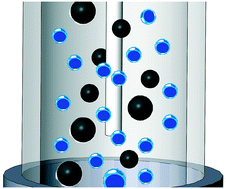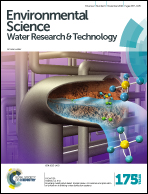An aerated and fluidized bed membrane bioreactor for effective wastewater treatment with low membrane fouling†
Abstract
Anaerobic fluidized bed membrane bioreactors (AFMBRs) use granular activated carbon (GAC) particles suspended by recirculation to effectively treat low strength wastewaters (∼100–200 mg L−1, chemical oxygen demand, COD), but the effluent can contain dissolved methane. An aerobic fluidized bed membrane bioreactor (AOFMBR) was developed to avoid methane production and the need for wastewater recirculation by using rising air bubbles to suspend GAC particles. The performance of the AOFMBR was compared to an AFMBR and a conventional aerobic membrane bioreactor (AeMBR) for domestic wastewater treatment over 130 d at ambient temperatures (fixed hydraulic retention time of 1.3 h). The effluent of the AOFMBR had a COD of 20 ± 8 mg L−1, and a turbidity of <0.2 NTU, for low-COD influent (153 ± 19 and 214 ± 27 mg L−1), similar to the AeMBR and AFMBR. For the high-COD influent (299 ± 24 mg L−1), higher effluent CODs were obtained for the AeMBR (38 ± 9 mg L−1) and AFMBR (51 ± 11 mg L−1) than the AOFMBR (26 ± 6 mg L−1). Transmembrane pressure of the AOFMBR increased at 0.04 kPa d−1, which was 20% less than the AeMBR and 57% less than the AFMBR, at the low influent COD. Scanning electron microscopy (SEM) analysis indicated a more uniform biofilm on the membrane in AOFMBR than that from the AeMBR biofilm, and no evidence of membrane damage. High similarity was found between communities in the suspended sludge in the AOFMBR and AeMBR (square-root transformed Bray–Curtis similarity, SRBCS, 0.69). Communities on the GAC and suspended sludge were dissimilar in the AOFMBR (SRBCS, 0.52), but clustered in the AFMBR (SRBCS, 0.63).



 Please wait while we load your content...
Please wait while we load your content...